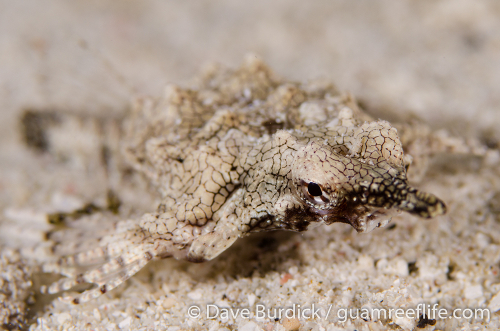This truly bizarre fish has elicited various names – dragon seamoth, dragonfish, and pegasus fish, but whether this fish reminds you of a flying insect, mythical beast, or something else entirely, I think you’ll agree that it is one of the stranger fish you’ll encounter while diving or snorkeling in the Indo-Pacific. Seamoths make up the family Pegasidae, named after the winged horse of Greek mythology. The pegasids are a small group (5 species) of bottom-dwelling fishes that are quite unusual in appearance, with flattened bodies encased in thick bony plates, a long snout, and large pectoral fins that extend from the side like wings. Seamoths “walk” along the bottom with modified pelvic fins and use their toothless, tube-like mouths mouths to suck up worms and other invertebrates. Curiously, seamoths can molt their bony plates quite frequently, perhaps as often as every five days. That seamoths even exists seems almost impossible, a fluke of evolution. But the odd shape and lumbering movement likely allow the seamoths to keep a low profile, and those predators that do target a seamoth have to contend with the armor of this tiny tank of a fish.
A single species of seamoth, Eurypegasus draconis, is known from Guam. This species, also known as the little dragonfish, short dragonfish, or dragon seamoth, is widespread across the Indo-Pacific, but it is rarely encountered in Guam’s waters. The individual in the above photograph was one of a pair observed on a sandy bottom in 6 feet of water. These two individuals were the only Eurypegasus I have see on Guam in the 13 years I’ve lived here, and I’ve only heard of two other sightings during this period. The pair could be reliably seen at the same site over a several month period, so if you find one chances are you could return to the same location and with a little searching find the same fish again. But certainly relish the time you spend with these curious critters – it’s unlikely you’ll come across another on Guam. Check out more images of this species here.

